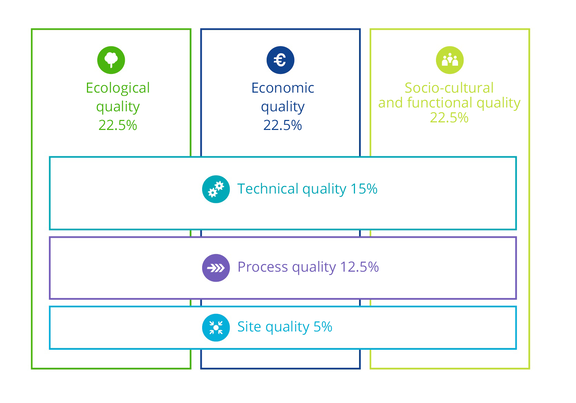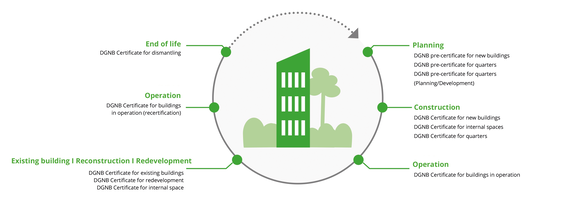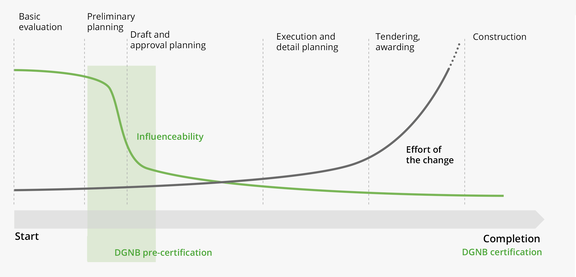![[Translate to Englisch:] dgnb](/fileadmin/_processed_/e/7/csm_neuerTitel-DGNB_43a2409d13.png)
In our description, we do not seek to endorse a specific building material, nor do we claim to know the only correct way of construction. Rather, it is about making a positive contribution for people, nature, climate and culture. This objective is decisive in sustainable building. The path towards achievement remains open to innovation and the creativity of the planners. This is the core philosophy of the German Society for Sustainable Building (Deutschen Gesellschaft für Nachhaltiges Bauen (DGNB)).
If you want to achieve sustainability goals such as the zero-energy standard, a circular construction method or a certain level of comfort, systematic planning is required. And if you want to be sure that all relevant sustainability topics are covered holistically, you should use a planning tool that goes beyond official requirements and shows when each aspect is to be taken into account.
For decades, so-called certification systems have been in place that precisely reflect this voluntary over-performance. One that is consistently dedicated to the implementation of holistic sustainability is the DGNB certification system. It includes six categories with a total of up to 37 criteria that describe in detail how a building becomes sustainable. That is why we would like to use the following pages to take a deeper look at this topic and present the criteria of the DGNB system in more detail.
Sustainability - what does it actually mean?
Sustainability is reflected in the three pillars of ecological, economic and socio-cultural quality. The following scenario shows clearly that these three aspects absolutely belong together in a sustainable building: A building that is environmentally friendly but cannot be sold because it is too expensive, cannot be called sustainable. Nor does it fulfill the requirements if it is inexpensive but doesn’t offer sufficient comfort. Last but not least, ecological measures should contribute to user comfort, not reduce it. For a building to be good in terms of sustainability, three other aspects are also relevant: The planning process, technical implementation and dealing with the local context. All six topics are covered in the DGNB system.
Particularly during the planning stage, it is essential to consider a building not only up to completion, but to include its entire life cycle. Starting with the extraction of raw materials, through the production of building materials and construction, right up to the operating phase and finally deconstruction, environmental impacts arise that are minimized and, above all, become transparent and calculable with appropriate planning. In addition to the ecological perspective, recording the life cycle costs provides a real estimate of the actual costs. Unwanted follow-up costs can thus be avoided, value preservation is ensured and building owners know what to expect in terms of maintenance or deconstruction in many years' time.
A holistic approach and consideration of the life cycle form the basis for the criteria of the DGNB certification system. Rather than simply working through the individual criteria, the system is to be understood as a planning and optimization tool that has the overall performance of the building as its objective. Rather than focusing on a particular building material that is supposedly environmentally friendly, the focus remains on its effect on the building's energy and resource balance.
Every building can make a positive contribution
What’s on your mind when you hear the term sustainable building? Perhaps a new wooden building or a multi-storey building with a green facade? It is less likely that you think of an ordinary building. Or an industrial area in the middle of nowhere. Yet this is precisely where sustainability is needed. After all, existing buildings account for a significant proportion of CO2 emissions due to their high energy consumption. Far too often, buildings are demolished and valuable resources end up in landfills.
The DGNB certification system is not reserved for new buildings. Rather, we understand it as a variety of different criteria catalogs, each of which relates to specific building tasks, uses and life phases. The DGNB system for buildings in operation e.g. helps to systematically lead existing buildings to climate neutrality. The DGNB system for dismantling ensures that as many materials as possible can be reused. And the DGNB system for quarters certificates entire city or business quarters. So in summary there is no building that cannot be optimized according to sustainability standards. In other words, every building can make a positive contribution to our environment.
A look at the ecological criteria:
climate protection needs specific implementation
Clearly, when it comes to the ecological consideration of buildings, climate protection is at the top of the list - a topic that has now also reached the construction and real estate industry. Everyone is aware that the fundamental aim is to cut greenhouse gas emissions, which are responsible for global warming. But it is only when we understand the relations and measure real CO2 consumption that saving becomes a real lever.
The 1.5-degree target set by the global community in the Paris Agreement in 2015 means that the global temperature is supposed to rise by an average of only 1.5 °C by 2100 compared to the start of industrialization in 1850. The negative impact of this ambitious target is already revealed in the reports of the Intergovernmental Panel on Climate Change. On this basis, we have to cut emissions by around 270 billion tons of CO2. If we continue as before, we still have six years until this balance is used up. This is underlined by the so-called CO2 clock of the Mercator Research Institute on Global Commons and Climate Change (MCC).
The building sector is responsible for about one third of CO2 emissions. Heating, cooking, cooling and generating electricity from fossil fuels make up one part. The other part is accounted for by so-called gray emissions. This refers to the CO2 emissions generated during the construction of buildings through the manufacture of building products, but also during repair, dismantling and the associated transport or disposal activities.
Here, the role of a concrete planning instrument becomes clear: The criterion of life cycle assessment prescribes that precisely these CO2 emissions be determined and calculated - over the entire life cycle of the building. In this way, different construction methods can be checked for their greenhouse gas potential with the aim of minimizing the CO2 footprint.
Life cycle assessment is one of six criteria attributed to ecological quality in DGNB certification. It also examines the risks to the local environment, for example from pollutants. In addition, it is important to ensure that all resources were obtained responsibly. Specifically, certain labels and standards are requested. But the promotion of biodiversity also plays a part and, in view of the serious situation regarding the extinction of species, is given even more importance. Last but not least, the avoidance of land sealing is promoted.
Socioculture and economy: the focus is on people
We spend 90 percent of our time indoors. Do we feel comfortable in our four walls? Eight criteria can be assigned to sociocultural quality that place people at the center. One key criterion is indoor air quality. If the risks to the local environment of building materials have already been examined in the area of ecology, it is crucial to measure the actual air quality after completion. Are the limit values of volatile organic substances, but also CO2 or fine dust particles complied with? Can it be ruled out that the health of allergy sufferers or children will be endangered?
In addition, the sociocultural qualities deal with thermal, acoustic and visual comfort. They ensure safety as well as accessibility and examine the extent to which quality of stay is provided indoors and outdoors. In office buildings, for example, the focus is on communication spaces, directions systems and attractively designed spaces for meetings. Last but not least, there are rewards if the users of the building can exert influence, for example on the climate and lighting.
Studies and reports from the real estate industry show clearly that certifying sustainable buildings is economically worthwhile. Demand for certificates from investors is increasing steadily. These buildings are also easier to rent and sell. The reason for this is the cost and value security over a long period of time. The criterion of life cycle costing provides the figures in black and white and ensures cost-efficient operation. In addition, the flexibility and convertibility of rooms and buildings can be assigned to the economic qualities. Last but not least, the criterion of marketability ensures that there is long-term market potential. For example, location, accessibility and parking space are taken into account.
Processes and location: planning is the key
Sustainable construction does not work without systematic planning. The principle is: The earlier the sustainability goals are arranged between the client and the planners, the less effort and costs are incurred. A whole eight criteria of the certification system are dedicated solely to process quality. For example, it describes how project preparation should be carried out, including requirements planning, sustainability specifications and public information. A central point is also the integration of relevant aspects in tendering and awarding. We know from our own experience that there is often a gap between the actual building performance and the planning. Building in a sustainable way means closing this gap by creating a kind of user manual for sustainable building operation. In addition, an orderly commissioning process should include monitoring and functional testing. Other process quality criteria deal with the construction process and quality assurance of the construction work, transparent user communication and FM-compatible planning. Last but not least, the design procedures used to achieve a high level of building quality are evaluated.
The first criterion for "Location", entitled Micro-Location, reads quite differently in light of the numerous headlines on extreme weather events in Germany. The aim of the criterion is to create resilient buildings that are protected from natural disasters and their specific effects at the site. The aim is to estimate probabilities of occurrence and the possible severity of the effects. This is also intended to reduce follow-up costs for essential retrofitting. Furthermore, the extent to which buildings provide a positive impulse for the location or the neighborhood is evaluated. This could be, for example, unusual building projects or a use that has a unique regional characteristic. In addition, the connection to sustainable mobility concepts is considered a location quality. Last but not least, it is examined whether the building users have access to important public facilities.
Building technology: less is more
The seven criteria of technical quality provide a benchmark for evaluating technical execution with regard to relevant sustainability aspects. From the DGNB's point of view: The basic rule is that building owners and planners should always ask themselves at which point technology is really needed inside or outside the building. Therefore, the first priority is to deal with the situation at the site. If the same or even better effect can be achieved with passive solutions, these should be preferred. For example, if the building is optimally aligned or there are no oversized windows, it may be possible to dispense completely with cooling systems and the environmentally harmful refrigerants they contain. Use and integration of building technology are described in detail in a criterion. In addition to the best possible use of passive systems, the aim is to integrate renewable energies for the required systems. In addition, the system technology should be accessible for retrofitting and later replacement without structural changes. Last but not least, it is considered positive if the systems are integrated into the existing energy infrastructure in the neighborhood in order to take advantage of synergies. A bonus is given, for example, if the building constantly draws energy from renewable energy sources in the vicinity or if it provides storage capacities in the sense of serving the grid.
The other technical criteria deal with sound insulation, emission control and the quality of the building envelope for minimum energy consumption with high comfort. But easy cleaning is also a sustainability criterion that should not be underestimated. If successfully implemented, it can avoid the use of cleaning agents on a large scale and thus save costs. A key criterion - especially with regard to technical systems - is the deconstruction and recycling-friendliness of building products and ultimately of the entire building. Here, too, there is a basic attitude that says: The less material is used and thus saved, the better. After all, a lot of energy is needed to manufacture building products and building materials, raw materials are becoming scarcer and landfills more expensive. The aim of the criterion is therefore to spread a way of thinking in line of the Circular Economy, which sees buildings as raw material stores of the future. Everything that is built should be deconstructed and returned to the cycle. Many innovative ideas are still needed.
Everyone can make a contribution
With the common goal: "Sustainable building is possible and can be put into practice," 16 pioneers joined forces in 2007 and developed the certification system. The fact that we can design, construct and operate buildings with a positive contribution already today is demonstrated not only by more than 7,000 certified new, existing and dismantling projects and neighborhoods, but also by numerous architectural awards. What all these projects have in common is, that they were exclusively created through teamwork and openness to new ideas. The client, architect and planner as well as the different disciplines all play their part in achieving a good overall result. Therefore, all that remains for us to do is to encourage everybody involved in construction to address the issues of sustainability and its design diversity.

German Society for Sustainable Building
(Deutsche Gesellschaft für Nachhaltiges Bauen – DGNB e.V.)
The DGNB is a non-profit organization with the aim of popularizing sustainable construction. With 1,400 member organizations, numerous expert committees and boards, it is Europe's largest network for sustainable construction. More than 5,500 people in 45 countries have already been trained as experts in sustainable construction with the DGNB Academy training and continuing education platform. With its certification system, the DGNB has developed a planning and optimization tool for evaluating sustainable buildings.



